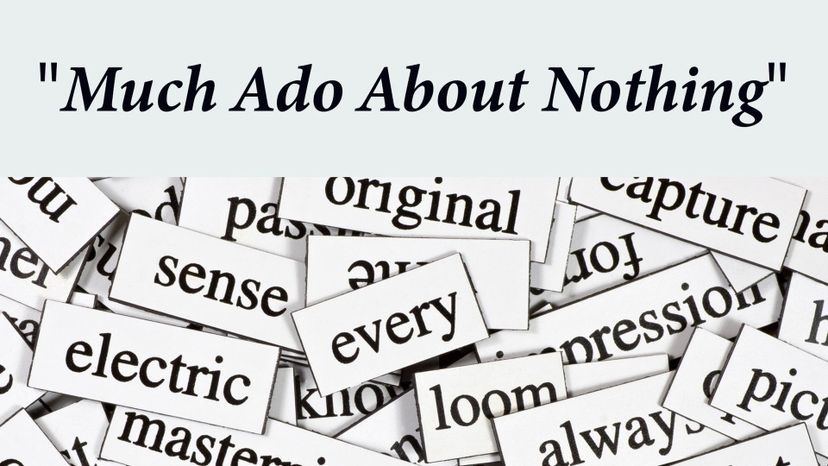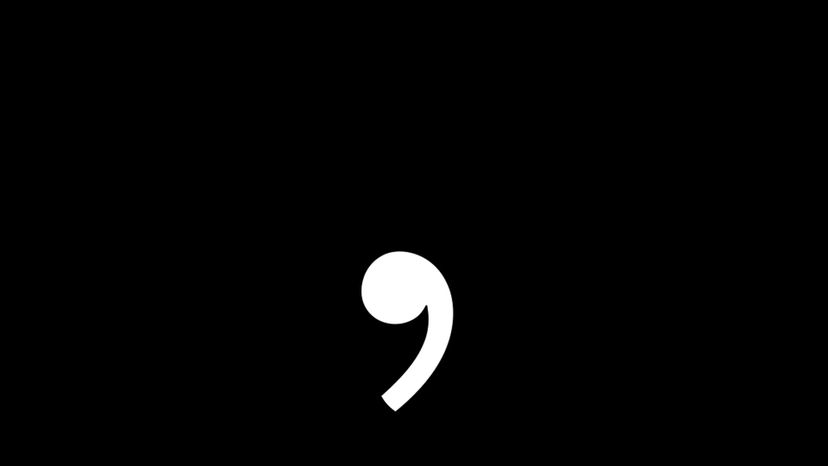
About This Quiz
For a structure to be sound, it must have a solid foundation. This is as true for a sentence or a paragraph as it is for a house or a skyscraper. In English, grammar provides both the material and the tools for constructing clear and understandable written communication. Although it may be the least fun part of writing, cultivating a basic familiarity with the rules can make all the difference between a bad writer and a good one. A real, in-depth understanding of grammar separates the skilled amateurs from the professionals who can really make their prose shine!Â
Whether you're writing an email, a term paper or the next great American novel, grammar should be embraced as a friend, not shunned as an enemy. If writing is art, then grammar is your oils and brushes, so why not have the best palette you can muster? After all, Michelangelo didn't paint the ceiling of the Sistine Chapel with a couple of broken crayons. And remember, you have to know the rules before you can break them.
This is a quiz for hardcore grammarians, but even if you don't know a split infinitive from split-pea soup, we invite you to come along on this journey into the cogs and gears of the English language. Have you got what it takes to conquer our advanced grammar challenge?

A suffix is a syllable or series of syllables (in linguistics called a "morpheme") added to a stem word to form a new word, change the meaning or alter the grammatical function of a word. For example, "-d" or "-ed" added to a regular verb will form the past tense of that verb.

This should be an easy one! Nouns are words that denote people, places, things, qualities, events, ideas or states of existence. This is probably the first thing you learned about grammar in grade school.

The most common word arrangement in English is the simple sentence constructed with a subject (a noun or pronoun) followed by a verb (an action performed by the subject) followed by an object (a noun or pronoun receiving the action). "He started the car" is an example of the form.
Advertisement

The two essential elements for making a sentence are the subject and the predicate. The subject is what the sentence is about. The predicate makes a statement about the subject with a word that expresses an action or state of being. The simplest sentences can be composed of just a noun and a verb.

A serial comma, also known as an Oxford comma or Harvard comma, is the last comma occurring in a list just before a coordinating conjunction like "and," "but" and "or." The use of a serial comma is largely a matter of style; however, it may lend clarity to the sentence.

An appositive phrase is a group of words that identifies or explains a word it adjoins. In the question, "a type of grain" is the appositive phrase. Set off by commas, it serves to define the subject "Spelt," adding clarity to the sentence.
Advertisement

When the subject has multiples elements, it is known as a compound subject. In this case, "Jack and Jill," two nouns joined by "and," are the compound subject. The action "went" is the verb beginning the predicate in this simple sentence.

"I," "he, "she," "you" and "it" and their inflected forms make up the category of personal pronouns. Personal pronouns take the place of the noun in a sentence to refer to the one speaking, spoken to or spoken about.

In order to make a complete sentence, the correct option is the singular verb "deliberates." "Jury" is a collective noun. In this case, 12 jurors make up the single unit that comprises the jury. When a collective noun is regarded as a single unit, it takes the singular verb form.
Advertisement

Adjectives are descriptive words used to modify a noun or pronoun. They usually come just before the word they modify. Adjectives can also be found in the predicate to complete the meaning of a sentence. For example, "skinny" and "hungry" are the adjectives in "The skinny cat looks hungry."

Introductory phrases should be followed by a comma. "Although it was unseen by the campers" is an introductory phrase (and a subordinate clause) giving context to the sentence. "The bear lurked nearby" is an independent clause that could stand on its own as a complete sentence.

Phrases have many functions in language. Some common types of phrases include noun phrases, verb phrases and prepositional phrases. Noun and verb phrases can be linked to form sentences as in "The early train (noun phrase) was late (verb phrase)."
Advertisement

Clauses are groups of words containing both a subject and a predicate. Independent clauses can work as full sentences. Subordinate clauses, however, can't work as a sentence because they begin with words like "because" or "which." They are used to elaborate on the independent clause.

Although its name may conjure the image of an overly long sentence, a run-on sentence, also called a comma fault or a fused sentence, occurs when two independent clauses are butted together as one sentence.

Compound sentences can be constructed by using a semicolon in place of a comma and "and" between the independent clauses. For example, "The hour was growing late, and we decided it was time to leave" can be altered to "The hour was late; we decided it was time to leave."
Advertisement

A pronoun is a word that can be substituted for a noun. Pronouns change form according to their function as the subject or object in a sentence. Some common pronouns are I, he, she, it, we, they, him and her.

Transitive verbs are verbs that express action and take a direct object. In the sentence "Giles kicked the can," "kicked" is a transitive verb because it has a direct object that is being acted upon: "the can."

Homonyms are one of the many elements of grammar that make the English language interesting and occasionally confounding. Some commonly confused homonyms are "there," "they're" and "their."
Advertisement

A fragment is a phrase or a subordinate clause written as a sentence. Beginning with a capital letter and ending in a period, a fragment lacks a subject, a predicate or both. Your high school English teacher likely told you to avoid fragments at all costs, but they can be effective in some writing.

Active voice reflects the direct action of the subject as in "The knife cuts" or "The pony gallops." The active voice is clear and strong. In passive voice, which your English teacher likely told you to avoid, the subject is acted upon by the verb as in "The bread was cut by the knife."

An infinitive is comprised of the word "to" followed by a verb. Placing a word, usually an adverb, between "to" and the verb splits the infinitive. To use split infinitives or not is a matter of style, not a rule, but if they're good enough for James T. Kirk, they're good enough for us!
Advertisement

The usage of "who" and "whom" is a sticking point for even the most adept of English speakers. In the question, the correct word is "who" because it's the subject of "works." In this sentence, "who" is performing an action. "Whom" is an objective form or the person receiving the action.

Nouns, verbs, adverbs and adjectives are called lexical words or vocabulary. They make up the bulk of the words found in the dictionary. These words are the basic building blocks of grammar.

The antecedent is the word or word group referred to by a pronoun. The antecedent usually precedes the pronoun, but in some cases, it may follow it. In the sentence "The captain steered his ship," "captain" is the antecedent of the possessive pronoun "his."
Advertisement

A gerund is a verb form that serves as a noun. It can have an object, complements or modifiers, which together make a gerund phrase. Here's an example. In the sentence "Eating vegetables is good for you," "Eating" is a gerund. "Vegetables" is its object making the gerund phrase "Eating vegetables."

Auxiliaries, also called verb markers, are helping verbs that precede the main verb. Two common auxiliaries are "be" and "have," as in "They will be studying in the library." In questions like "Have the children eaten lunch?" other words may occur between the auxiliary and the main verb.

The use of a noun or a pronoun in a sentence determines its case. In English, there are three cases: subjective (or nominative) as when used as the subject, possessive (genitive) as when showing ownership, and objective (accusative) as when used as the object or subject of a preposition or verb.
Advertisement

A complex sentence is comprised of one independent clause and at least one subordinate clause. The sentence "Although I missed the bus, I arrived on time" is made up of the subordinate clause, "Although I missed the bus," followed by a comma and the independent clause, "I arrived on time."

The words "a," "an" and "the" are called articles. They are used as adjectives that signify that a noun is to follow. "The" is a definite article referring to a distinct noun; "a" and "an" are indefinite articles that don't indicate a specific noun.

English sentences can be divided into four categories of statements: declarative (statements), imperative (commands or requests), interrogative (questions) and exclamatory (exclamations). The example, "Go back now!" is a command making it an imperative statement.
Advertisement

Generally speaking, words are grouped into eight parts of speech. They are nouns, verbs, adjectives, pronouns, adverbs, prepositions, conjunctions and interjections. Understanding the functions of each is the bedrock of grammar.

Words showing relationship such as "about," "between" or "with" are prepositions. Prepositions always have objects. The preposition, its object and any modifiers included make a prepositional phrase. In the sentence "The seal was on the beach," "on the beach" is the prepositional phrase.

Tense, a determination of time, is denoted by the principal parts of verbs. The principal parts are present, present participle, past tense, and past participle. For example, "give," "giving," "gave" and "given" are the principal parts of the verb "give."
Advertisement

"Lie" and "lay" are often confusing for even the most advanced students of grammar, especially when identifying their principal parts. "Lie" is to assume a state of repose. Its past participle can be conjugated as "has lain." "Lay" means to place something. Its past participle is "laid."

A compound sentence is made up of at least two independent clauses linked by a comma and a coordinating conjunction like "and" or "but." The clauses in a compound sentence could each function as complete sentences.